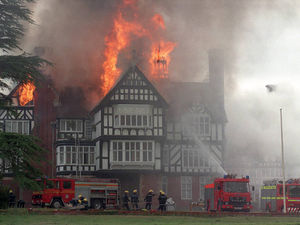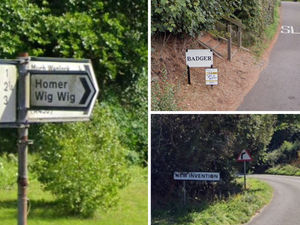Tragic, forensic and fascinating: The life of a professional fire investigator
As France reeled with shock after the devastating fire at Paris’ iconic Notre Dame cathedral, an investigation into how the blaze started soon got under way.

Those examining the scene were using the same skills and techniques to determined what triggered the inferno that are used by fire investigators closer to home.
When a fire tragedy strikes, it’s James Holder’s job to provide answers for those who have lost homes, businesses or loved ones.
Digging through debris
As a fire investigator, his role is to carefully and methodically comb the scene for clues to determined how a blaze started.
“Digging through fire debris is not that different from archaeology,” he says. “From the moment a fire starts, debris starts to layer up and creates a timeline.
“The fire might start by a heater but then that will be covered with other debris as the fire spreads, maybe falling tiles from the ceiling or charred furniture that’s collapsed.
“All of this will be covering the remains of the heater which may well be the cause of the fire so I have to remove all of the layers to get to what is at the bottom.
“The lower debris is more important than what’s at the top because this will contain key evidence that might point to the cause of the fire.”
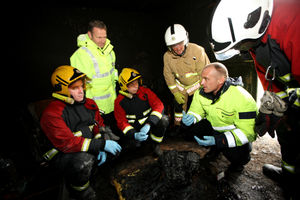
He continues: “It’s all about going back in time to find out what was there at the start.”
Mr Holder, who works for West Midlands Fire Service, is part of a team of five fire investigators who between them provide a 24/7 call out service responding to incidents where there has been a fatality or serious injury, huge financial loss and suspected arson as well as those where a cause can’t be determined by fire fighter crews.
“For smaller fires crews will investigate after they’ve put the fire out but when it’s more serious or complicated we are on-call to assist.
“We will investigate the cause and if somebody has been killed write a report for the coroner or where a crime has been committed produce a statement for police which may be presented in court,” says the 41-year-old, who has been in the role for eight years and also supports Staffordshire Fire and Rescue Service.
'Fatalities are the worst'
During that time he has investigated more than 200 incidents with, sadly, about 50 involving a fatality.
These included a blaze at SP Fireworks in Baswich, Stafford where two people perished in a huge explosion and a house fire in Stourbridge where a woman accidentally set herself on fire while smoking and inhaling hairspray fumes.
He says being at a scene where someone has been killed is the most difficult part of the job, but it’s vital he puts his own emotions aside to fully focus on searching for clues.
“I can’t get emotionally attached to what I am seeing because I don’t think I can do my job properly if I do.
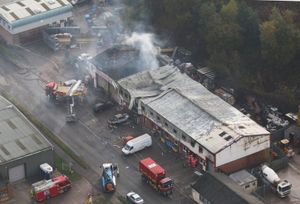
“It sounds wrong but I have to look at a dead body in the same way I would look at a sofa as I gather evidence.
“I’ve seen far more than when I was on a fire engine. I think the worst one I’ve been too was a fire in which an 18-month-old died.
“These are the worst kind of fires but at least I can offer a bit of comfort to families by providing them with information about what happened to their loved one,” says Mr Holder.
He has worked for the fire service for 21 years, first joining as a firefighter before later working his way up the later to the position of watch commander.
“Within a year I had unfortunately attended my first fatal fire,” he adds. “I found myself fascinated as I watched the fire investigator at the scene looking at the charred remains to determined the fire’s origin and cause.
Jigsaw puzzle
Every fire scene is approached in exactly the same way to ensure every possibility is considered.
“It is imperative that investigators maintain an open mind and remain completely impartial.
“Establishing that a property had been subjected to three previous arson attacks does not preclude the fourth fire from being the result of an accident,” says James, who is a member of the United Kingdom Association of Fire Investigators.
Fire investigators can be called out within 20 to 30 minutes of the alarm first being raised but research begins before they’ve even reached the scene.
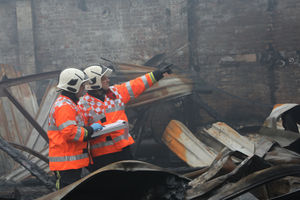
“I liken a fire investigation to collecting the pieces of a jigsaw puzzle.
“If all the pieces to the jigsaw can be found, then the picture becomes crystal clear.
“However, at the point that I am notified of my requirement to attend a fire scene, I have no pieces to the jigsaw, and my quest for those missing pieces begins.
“Obviously, the more pieces I can find then the clearer the picture becomes, and so, the investigation of a fire begins before I even leave my office.
“Any previous fires are clearly of interest to me, and any other intelligence relating to a particular address is recorded,” explains Mr Holder.
Evidence
If it’s a fire at a business, his research will include finding out information relating to type of building and what it might contain.
He also checks the map to see where the property is located and what is in the vicinity, paying attention to any nearby canals, railway lines or alley ways.
Once he arrives at the scene, he talks to the firefighters who attended to find out what they saw and how they gained access to the property.
“In most cases, when a crime occurs, the longer the crime is in progress, the more evidence is produced,” Mr Holder adds.
“Evidence at a fire scene, on the other hand, diminishes as time passes because the fire destroys more and more of what evidence there was.
“The actions of the first responders to any fire scene are therefore vital to the preservation of any remaining evidence.
“As a fire investigator, it is imperative that I obtain the accounts of these first responders regarding their actions and observations.”
Next he will talk to any witnesses to the fire, who might include occupants of the property at the time, neighbours or passers-by.
“The checking of witness evidence for its reliability, however, cannot be overemphasised.
“Witnesses can be deliberately untruthful, whether that be because they would implicate themselves in a crime or demonstrate that their negligence caused the fire, albeit accidentally.
“People may inaccurately describe what they saw, whether that be because of excitement, upset or other emotions experienced by people who may well have not been exposed to such an incident before.
“The ‘ABC’ rule of thumb in fire investigation is to “assume nothing, believe nobody and check everything”’, and remember that witnesses can be mistaken, or lie of course, and physical evidence does not.
CCTV, social media and Right Move clues
Later he will also check CCTV in the area as well as social media which could both hold vital clues.
“Footage captured by CCTV cameras is an obvious source of reliable data, and time invested in checking for cameras in the local vicinity is time well spent.
“I recall one case where CCTV footage obtained, although scant and which did not record the fire itself because it faced the wrong direction, did capture a passing vehicle that was later traced,” says Mr Holder, who was a watch commander in Foleshill, Coventry.
“Although the sole occupant of the passing car couldn’t recall seeing anything to assist the investigation themselves, the on-board dashboard camera fitted to their vehicle did.
“Photos and videos on social media have become really useful because they can take us further back in time than our best witness.
“Right Move is also really useful if a house has been sale as it can give an idea of how it looked before.
“Doorbell cameras are also useful because they are becoming more common and they capture the movement of people,” he adds.
Homing in
The degree of charring to the wood, the moisture loss from gypsum plaster board and the presence of electrical arcing on circuits are among the techniques that allow investigators to ‘home in’ on where a fire started.
Using tools including hand trowels, magnets and small brushes, they will examine physical remains.
“Sources of ignition that are often found even in the most severe of fires include electrical components of failed appliances, tea-light candles carcasses and cigarette lighters,” says Mr Holder.
Sometimes the evidence may not always point him the right direction.
“I might find signs of petrol in a house which could be a sign of arson but then discover the owner services his lawn mower in the kitchen.
“This is means there is explanation for the petrol being there.”
“It’s important to find out about the habits of the people living there and look for other evidence,” he continues.
“Signs of petrol coupled with a forced entry for example would be a clearer indicator of arson.”
Eliminating one by one
One by one he will eliminate causes that don’t fit with the evidence he has gathered at the scene until he is satisfied he has identified the right one.
“It’s rare that we don’t identity the cause, sometimes it might be that all the evidence points to a fire being started by a discarded cigarette but the back door was open so we can’t rule out completely someone coming in from outside.”
The job, he says, is rewarding – especially when he successfully provides valuable information to families and business owners.
“We get to go back in time to what was happening at the time of a fire. I still find that fascinating.
“I get to meet lots of different people from all walks of life and it’s really interesting. I used to get a buzz from going out on a fire engine to an emergency and now I get a buzz from finding out what happened,” Mr Holder adds.

